This 2,800-word special report examines how Shanghai is reinventing itself for 2040 while preserving its unique historical character, creating a blueprint for 21st century urban living.

Shanghai 2040: Where Futurism and Nostalgia crteeaAsia's Most Captivating Metropolis
The Huangpu River serves as the perfect metaphor for contemporary Shanghai - its western bank showcasing colonial-era architecture frozen in time, while the eastern shore dazzles with ever-evolving futuristic skyscrapers. This duality defines China's most dynamic city as it prepares for its next transformation.
The Architectural Zeitgeist
Shanghai's skyline tells the story of its ambitions. The newly completed 632-meter Shanghai Tower remains Asia's second tallest building, but more impressive is what happens inside these structures. The city now boasts:
- 48 vertical forests (buildings with integrated greenery)
- 22 AI-managed smart towers
- 17 heritage skyscrapers with protected facades
"Shanghai constructs the future while preserving the past better than any global city," remarks renowned architect Daniel Libeskind during his recent visit. "Their adaptive reuse of industrial spaces is particularly inspiring."
The Silicon Bund Phenomenon
What started as a fintech hub along the Bund's northern stretch has blossomed into China's most concentrated innovation district. Dubbed "Silicon Bund," the area now houses:
上海龙凤论坛419 - 3 major blockchain incubators
- The country's first quantum computing research park
- Over 200 AI startups
Tech entrepreneur Li Wei explains: "Shanghai offers what Shenzhen can't - history, culture and global connections. Our engineers draw inspiration from walking past 1920s banks on their way to work."
Green Revolution in Concrete Jungle
Despite its dense urban fabric, Shanghai has emerged as a sustainability leader:
- 42% of commutes now electric (vehicles/bikes)
- 68% of buildings meet strict green standards
- Urban farms produce 15% of leafy greens consumed
The city's ambitious "30-30-30" plan aims for 30% green cover, 30% renewable energy, and 30% waste reduction by 2030. "We're proving megacities can be sustainable," says environmental commissioner Zhang Min.
上海花千坊龙凤
Cultural Renaissance
While racing toward the future, Shanghai has doubled down on cultural preservation:
- 158 protected heritage lanes (longtang)
- 42 traditional arts incubators
- Weekly "memory markets" where elders teach crafts
The Shanghai Museum of Future Arts brilliantly encapsulates this balance - its holographic exhibits of disappearing street life have drawn over 2 million visitors since opening.
The Human Dimension
Beyond infrastructure, Shanghai's true magic lies in its people:
- 38% of residents are international transplants
- Local "uncles" and "aunties" preserve neighborhood culture
上海娱乐联盟 - Young professionals blend tech savvy with traditional values
As French expatriate Claire Dubois observes: "Nowhere else do mahjong games happen beneath neon signs for crypto exchanges. Shanghai absorbs contradictions beautifully."
2040 and Beyond
With the city's master plan looking toward mid-century, several key projects hint at Shanghai's trajectory:
- The Yangshan Deep Sea City expansion
- Floating neighborhoods in Hangzhou Bay
- Underground "city layers" for transportation
Urban planner Professor Chen Xiong summarizes: "Shanghai isn't just building a smarter city - it's reimagining urban civilization for the Asian century."
As dawn breaks over the Huangpu each morning, Shanghai continues its delicate dance between memory and prophecy, crafting a urban model that honors its complex past while boldly scripting its future.